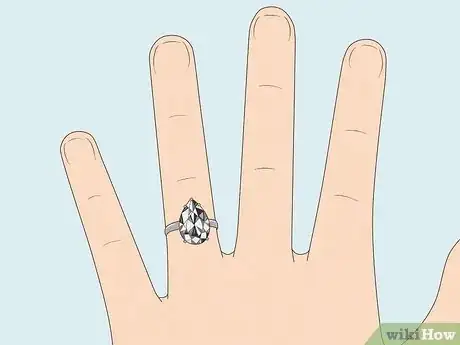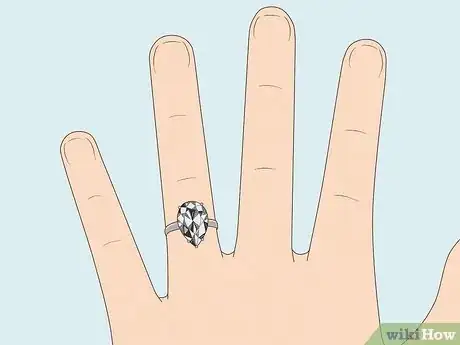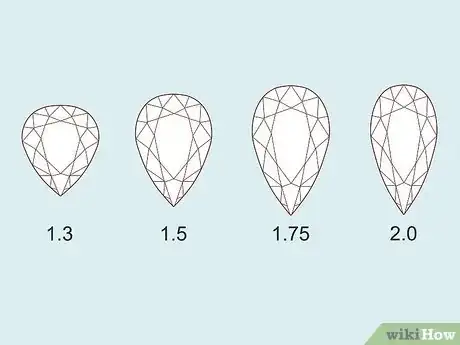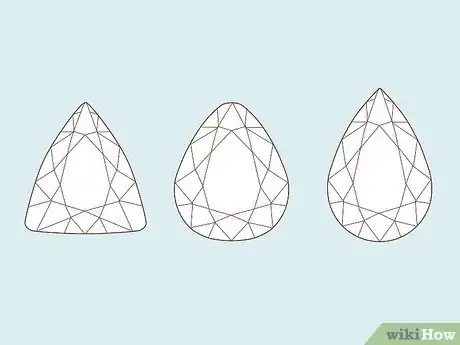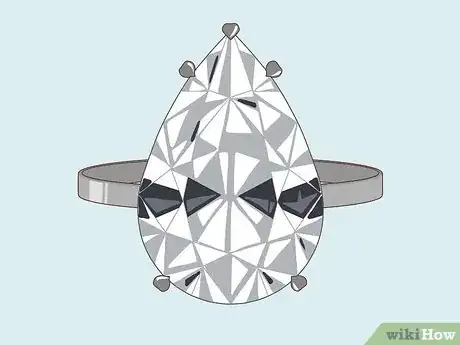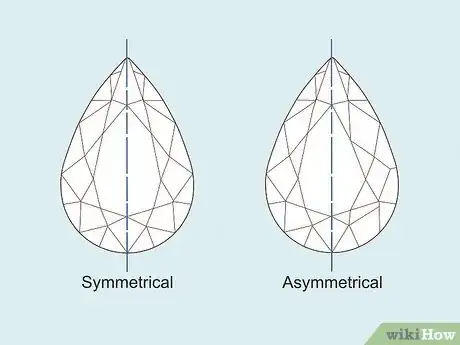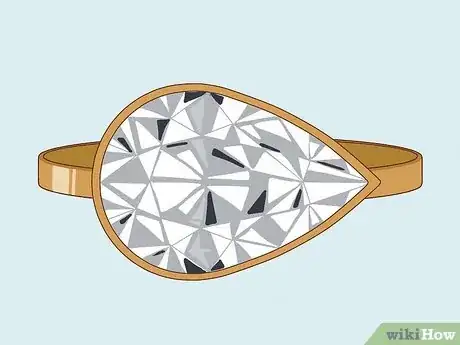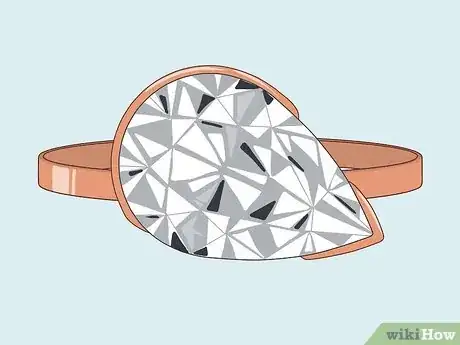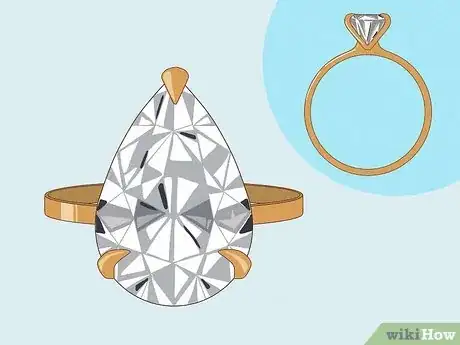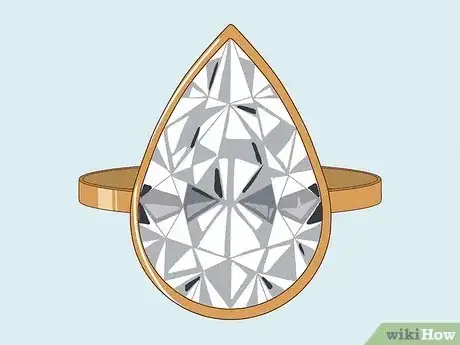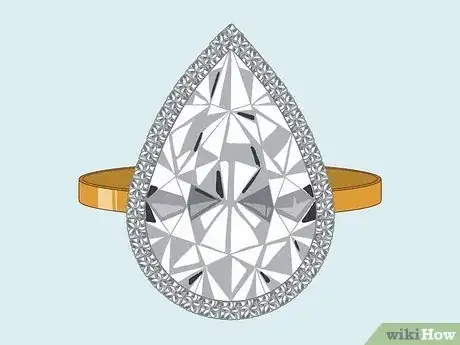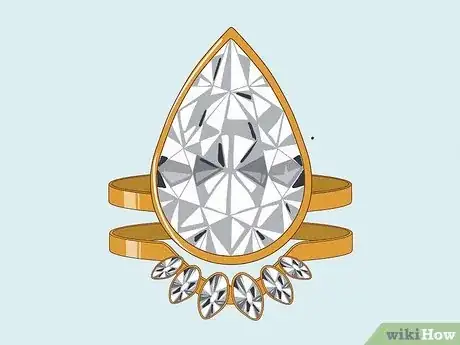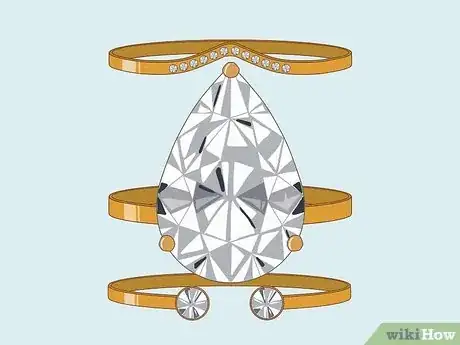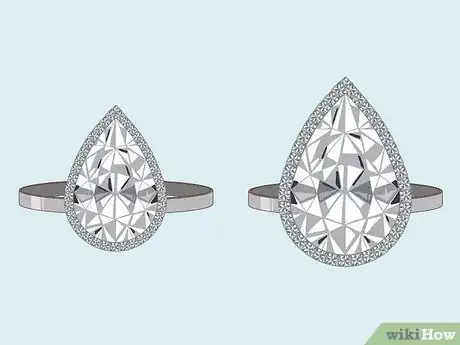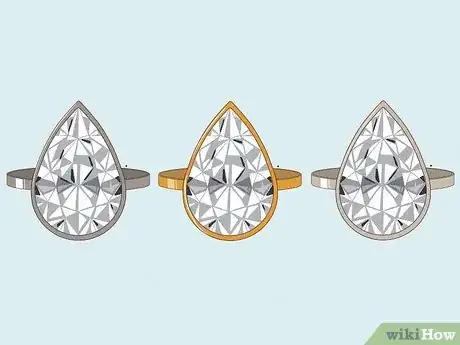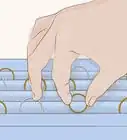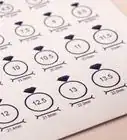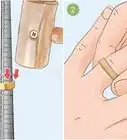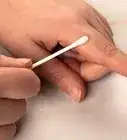This article was co-authored by Nicole Wegman and by wikiHow staff writer, Devin McSween. Nicole Wegman is the Founder and CEO of Ring Concierge, a New York City-based fine jewelry brand. Specializing in engagement ring and wedding band trends, Ring Concierge creates a luxury experience catered towards millennials. Ring Concierge offers engagement rings along with earrings, necklaces, bracelets, and anklets. Nicole's work and Ring Concierge have been featured in Vogue, Glamour, Who What Wear, Martha Stewart Weddings, Brides, and Cosmopolitan. Nicole is a GIA (Gemological Institute of America) Accredited Jewelry Professional and holds a BS in Fiber Science and Apparel Design from Cornell University.
There are 7 references cited in this article, which can be found at the bottom of the page.
This article has been viewed 8,302 times.
Known for its unique shape, dazzling display, and romantic aura, a pear shaped ring makes for a beautiful engagement or wedding ring. If you are shopping for a pear shaped ring and aren’t sure how to style it once it’s on your finger, we’ve got you covered! Ultimately, there’s no right way to wear a pear shaped ring – any direction, style, or setting you choose will look striking and elegant on your hand. However, we’ll give you advice on what to be mindful of when buying a pear shaped ring and what settings and styles work well with it.
Things You Should Know
- Wear your ring with the pointed tip facing your finger tips for a classic look that elongates your hands, or towards your hand for a dramatic statement.
- Inspect pear shaped rings for balanced proportions, symmetrical diamonds, and the prominence of a bow-tie shadow.
- Choose a setting that emphasizes and protects your pear, such as the prong, halo, or bezel setting.
Steps
Wear the tapered tip towards your finger.
-
Make your hand appear slender with this traditional choice. While there is no correct way to wear your pear shaped ring, most people choose to place their ring so that the pointed tip faces their fingertips. In addition to giving you an elegant, elongated hand, this also gives you a full view of the tear drop shape.[1] X Research source
Face the tapered tip towards your hand.
-
Or, make a statement by choosing a less common way to wear your ring. Facing the pointed end towards your hand is a less popular choice that is great for those who want to stray from the norm. This dramatic look is also a great choice because your ring is less likely to get caught on your clothes and cause snags.[2] X Research source
Check your diamond’s length to width ratio.
-
Choose a balanced, long, or wide pear shaped ring. Most jewelers cut pear shaped diamonds to a length and width ratio of 1.50 to 1.75, which gives you the classic, perfectly tapered pear shape.[3] X Research source
- If you want a longer, slimmer look, choose a diamond with a higher ratio of 1.8 to 2.0.
- Or, if you prefer the look of a wider diamond, look for a smaller ratio of 1.3 to 1.4.
Inspect the diamond’s shape.
-
Look for a rounded end and a crisp, sharp taper. Some pear shaped rings are cut so that the rounded end is more flat than curved, giving it a more triangle appearance. On the opposite end, some diamonds are cut curvy without a defined taper into the pointed tip.[4] X Research source
- If you want a traditional, true teardrop shape, look for a clear semicircle that rounds nicely into the sharp point.
- On the other hand, triangular and curvy pear shaped rings are beautiful options that give you a more unique, one-of-a-kind look.
Be mindful of the bow-tie effect.
-
Inspect the shadows that appear in the center of the ring. When you look at pear shaped rings, you will notice that light bounces off the center and creates a bow-tie shape. The bow-tie doesn’t affect the diamond’s beauty, but do test out rings under different lighting and angles to see how prominent it looks.[5] X Research source
- Some rings have very apparent bow-ties while others are nearly invisible.
- The bow-tie appears due to the diamond’s cut, which is actually a combination of two different cuts. The pear shaped ring gets its curved edge from the brilliant round cut while the marquise cut provides the distinctive, sharp taper.[6] X Research source
Look for a symmetrical diamond.
-
Examine pear shaped rings for a perfect cut. To find the perfect cut for you and your style, imagine that there is a line running directly down the diamond. This will show you if the diamond is cut symmetrically or has irregularities that might make it look crooked or unbalanced.[7] X Research source
- Symmetrical rings are great for a more traditional and classic look, while asymmetrical rings have more character and uniqueness.
Choose a horizontal diamond.
-
Stand out with a more contemporary diamond placement. A horizontal pear shaped ring is less common than the vertical variety, which is sure to give you a unique edge. In addition to its striking appearance, a sideways facing diamond is less likely to catch on your clothes.[8] X Research source
Go for an off-center, asymmetric diamond.
-
Make your ring as funky and different as you are. If you don’t want a perfectly vertical, horizontal, or centered pear shaped ring, you don’t have to settle for one. Choose a slightly off-kilter or diagonally facing diamond for a fun and fresh vibe.[9] X Research source
- Make this ring even more unique with a different cut stone attached to the pear, or go with an aquamarine or opal stone instead of a diamond.
Choose a prong setting.
-
Go for a classic look that emphasizes your diamond. The V shaped prong setting is a timeless choice that is certain to make your diamond pop and turn heads. The prong setting is also a great choice because it secures the tapered end of your pear shaped ring, which can be susceptible to chipping and breaking.[10] X Research source
Select a bezel setting.
-
Highlight the tear drop shape with a sleek border. If modern and minimal is more your vibe, a metal bezel setting is the perfect option. This shows off the pear shaped ring’s unique contour and can make your diamond look even larger. As a bonus, the bezel setting protects your diamond and prevents snags.[11] X Research source
Pick a halo setting.
-
Turn heads with a glam and ultra sparkly setting. In a halo setting, the pear shaped diamond is surrounded by accent diamonds or gemstones, giving you a brilliantly shining ring that will make you stand out. This style can also make your pear shaped diamond look larger than it really is.[12] X Research source
Pair it with a contour ring.
-
Fit a ring over or under the pear’s rounded edge. If you’re choosing a pear shaped engagement ring, a contoured wedding band is the perfect addition to your finger. Contoured rings dip in the middle, allowing the curved part of your pear shaped ring to rest in the dip. The contour also allows you to wear the ring under or on top of your pear shaped ring.[13] X Research source
Style it with stacking rings.
-
Stack an open or chevron ring with your pear shaped ring. An open ring is a great stacking choice because the middle of the ring is left open, fitting your pear diamond neatly inside. You can also highlight the pointed end of your pear shaped ring with a V shaped chevron ring.[14] X Research source
- Try mixing metals with your stacking rings. Style yellow gold rings with a silvery pear shaped ring for a bold and eclectic look. For a more subtle look, pair together rings of the same metal but in a different tone.
Find a diamond size that compliments you.
-
Choose a diamond size that works for your features and budget. People with petite hands often choose smaller diamonds that don’t overwhelm them, while people with larger hands may want a bigger stone to enhance their features. Pear shaped diamonds are budget friendly because they appear larger than they actually are and typically cost less![15] X Research source
- In general, pear diamonds run about 10-30% less than round diamonds, but look larger and brighter due to the combined brilliant round and marquise cuts.
- A diamond’s size and price is determined by its weight in carats (1 carat is equal to 200 milligrams).[16] X Research source
- Small diamonds can range from anywhere between 0.05 to 1.0 carats. Larger diamonds are typically 1.0 carats and up.
Select a metal that works for your style.
-
Consider tone, durability, and price when choosing a metal. Yellow gold is the most popular metal due to its warm tone and ability to make your diamonds really pop. If you are drawn to cooler colors, platinum and white gold are timeless and classy options, though typically more expensive.[17] X Research source
- You can go for a warm, less traditional option with a rose gold metal that gives your pear shaped ring a vintage vibe.
- If you want a dark, unique and edgy look, choose a titanium ring.
- The amount of karats, or amount of pure gold, in your ring affects your price. Most jewelers recommend 14 to 18 karat gold for its rich color and durability. Pure, 24 karat gold is very expensive but also very soft and prone to dents.
You Might Also Like
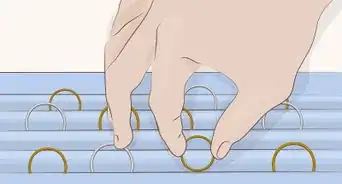
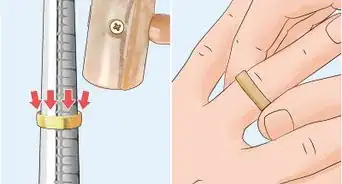
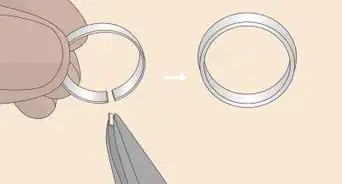
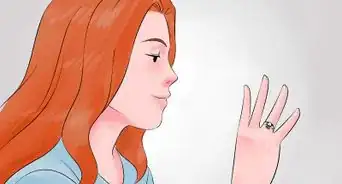
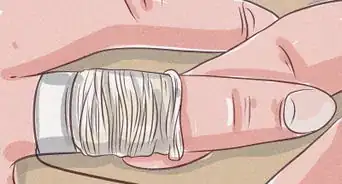
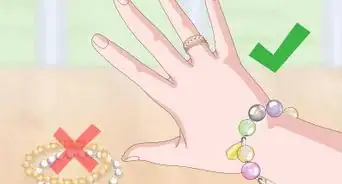

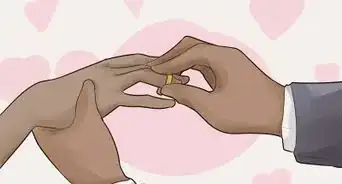
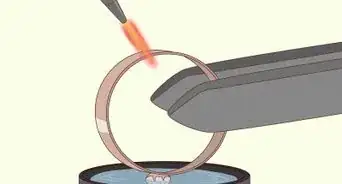 11 Easy Ways to Get Your Girlfriend's Ring Size Without Her Knowing
11 Easy Ways to Get Your Girlfriend's Ring Size Without Her Knowing
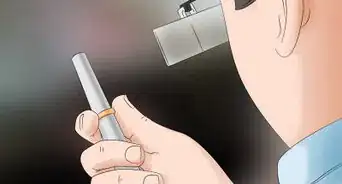
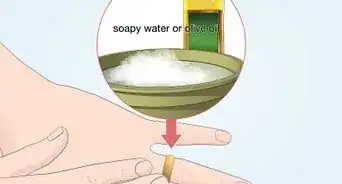
References
- ↑ https://4cs.gia.edu/en-us/blog/pear-shaped-diamond-tips-picking-perfect-one/
- ↑ https://4cs.gia.edu/en-us/blog/pear-shaped-diamond-tips-picking-perfect-one/
- ↑ https://www.diamonds.pro/education/pear-shaped/
- ↑ https://www.gemsociety.org/article/pear-shaped-diamond-guide/
- ↑ https://4cs.gia.edu/en-us/blog/pear-shaped-diamond-tips-picking-perfect-one/
- ↑ https://4cs.gia.edu/en-us/blog/pear-shaped-diamond-tips-picking-perfect-one/
- ↑ https://www.gemsociety.org/article/pear-shaped-diamond-guide/
- ↑ https://4cs.gia.edu/en-us/blog/pear-shaped-diamond-tips-picking-perfect-one/
- ↑ https://www.1stdibs.com/blogs/the-study/pear-shaped-rings/
- ↑ https://www.gemsociety.org/article/pear-shaped-diamond-guide/
- ↑ https://4cs.gia.edu/en-us/blog/pear-shaped-diamond-tips-picking-perfect-one/
- ↑ https://www.diamonds.pro/education/pear-shaped/
- ↑ https://www.vrai.com/journal/post/guide-to-stacking-rings
- ↑ https://www.vrai.com/journal/post/guide-to-stacking-rings
- ↑ https://www.gemsociety.org/article/pear-shaped-diamond-guide/
- ↑ https://4cs.gia.edu/en-us/diamond-buying-guide/
- ↑ https://www.gemsociety.org/article/ring-metal-options/
About This Article

